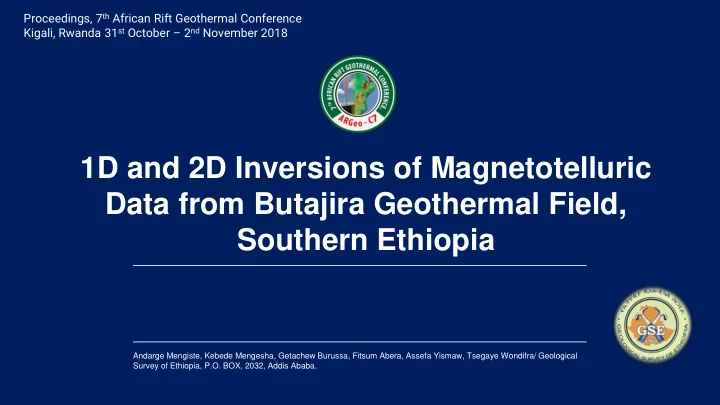

Proceedings, 7 th African Rift Geothermal Conference Kigali, Rwanda 31 st October – 2 nd November 2018 1D and 2D Inversions of Magnetotelluric Data from Butajira Geothermal Field, Southern Ethiopia Andarge Mengiste, Kebede Mengesha, Getachew Burussa, Fitsum Abera, Assefa Yismaw, Tsegaye Wondifra/ Geological Survey of Ethiopia, P.O. BOX, 2032, Addis Ababa.
Outline Introduction The Magnetotelluric Method 1D and 2D Inversions Results and Discussions Conclusions and Recommendations 2
Preface Erupted well 2014 Current situation 3
Introduction Butajira - located in the western escarpment of CMER & characterized by: Pyroclastic flow deposits and Basaltic out crop Geothermal manifestation Rich in ground water Lacustrine sediment Figure 1. 3D DEM map showing physiography of the study area 4
Introduction Cont. Geothermal Manifestations Figure 2. Crater Lake ( Har Shetan), active mud pool and occasional geyser ejected and warm spring which indicate thermal activity in sub surface 5
Introduction Cont. Geo Geologica logical l map map Figure 3. Geological map of study area (modified after Zelalem Abebe and Yared Sinetibeb, 2017). 6
Introduction Cont. Obje Objectives ctives of of the the stud study Obtain a model of the subsurface resistivity structure of the Butajira geothermal field Estimate the probability of occurrence, extension and depth of the geothermal reservoir and possible recharge zones for the system Advance the state of knowledge of the prospect to one level Increase rate of survey coverage 7
The Magnetotelluric Method A passive EM geophysical method which measures the natural electromagnetic signals The natural source of energy of Magnetotelluric signals: High frequency signal, >1 Hz Low frequency signal, <1 Hz 8
The Magnetotelluric Method Cont. MT s MT survey urvey layout, data process layout, data processing, data qual ing, data quality and ity and invers inversion ion Figure 4. Schematic set up of MT survey lay out(JICA 2015) and data processing and inversion flow. 9
The Magnetotelluric Method Cont. The The MT imped MT impedance t ance tensor and dimensio ensor and dimensionality nality 1D case, it is enough to calculate E and H independently on their orientation. 2D and 3D cases, we need to measure in different spatial components of EM-fields. = Skin depth (km) 10
The Magnetotelluric Survey in Butajira 32 MT stations Were surveyed Remote reference technique was applied Figure 5. MT observation points and remote reference station 11
The Magnetotelluric Data Quality Data quality Data quality Most of the sounding data is a medium quality and can be interpreted up to 100 second period length Figure 6. Example of raw and processed MT data of station number of BTJ074. 12
MT Sounding Curves plotted at different frequencies Figure 6. Trend of sounding curves at different frequencies. 13
Dimensionality Analysis 14
Inversion and Modelling 1D MT Inversio 1D MT Inversion Levenberg-Marquardt, a non-linear least square method and can be done by minimizing the objective function F. F = ( d – g ( m 0 + Δm )) + λ|| Δm || 2 Where F = objective function d = data (apparent resistivity and phase) g = forward operator m = solution models Δm = model parameter updates m 0 = initial model λ = parameter that shows effect of model perturbation or damping factor 15
1D MT Inversion Cont. 1D Marquardt Inversion and Modelling of Station B58 along P4 Parameter Initial Final Fix rho 1 10 6 0 rho 2 17 51.3 0 rho 3 2 3.86 0 rho 4 25 729 0 rho 5 6 2.15 0 thic 1 100 34.5 0 thic 2 250 141 0 thic 3 500 1654 0 thic 4 250 10140 0 Iteration 16 RMS 0.48 16
2D MT Inversion 2D Occam inversion At k-th iteration, the estimated model parameters are obtained by solving the following equation: T ∂ z ) + ( WJ k ) T WJ k ] -1 ( WJ k ) T W m k+1 = [µ ( ∂ y T ∂ y + ∂ z where m = matrix of model parameters k = number of iteration, µ = Lagrange multiplier ∂ y = roughness matrix to describe different model parameter laterally ∂ z = roughness matrix to describe model parameter vertically T = transpose of matrix W = weighted diagonal matrix J = Jacobian matrix 17
2D MT Inversion Cont. Param Paramete eters rs used used fo for r 2D inversion 2D inversion Strike angle rotation = 75 ° TE + TM Maximum number of iteration = 20 Target RMS = 0.5 Half space resistivity = 20 Ω m 18
2D MT Inversion Cont. Strike Strike Direct Direction ion Strike direction is taken between period of 100-1000 seconds 19
2D Data and Response of TE Mode along Profile 3 Figure 7. Pseudo Section of TE Mode along P3 20
2D Data and Response of TM Mode along Profile 3 Figure 8. Pseudo Section of TM Mode along P3 21
1D Results and Discussions Results of 1D Resistivity sections along profiles P1, P2, P3 and P4 22
2D Results and Discussions Results of 2D Resistivity models along profiles P1, P2, P3 and P4 23
Conclusions and Recommendations The MT method detected a low resistive surface layer (< 10 Ωm ) of up to about1.5 km thickness, can be correlated as alteration zones caused by geothermal activity or lacustrine sediments or hydrothermally altered clay cap. Below this low resistive layer resistivity is increasing up to (10-60 Ω m). This indicates the advancement to a possible reservoir at depth below 1500 m with a thickness of about 1 Km. The faults have been detected on the profiles 1 and 2, so it is strongly recommended to have addition profiles on this portion in order to understand the extension of the fault and reservoir Additional MT/TEM stations and 3D MT survey are recommended Gravity survey is also recommended to delineate the geological structure 24
Thank you Andarge Mengiste/ Geological Survey of Ethiopia, P.O. BOX 2032,Addis Ababa, Ethiopia andmeng70@gmail.com www.thearge.org/C7
Recommend
More recommend